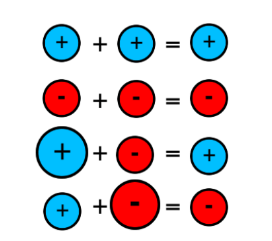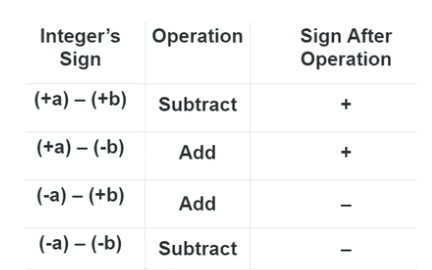Important Formulas: The Other Side of Zero | Mathematics for Class 6 PDF Download
1. Positive Numbers are numbers with a ‘+’ sign in front, such as +1, +2, and +3. They represent numbers greater than zero.
2. Negative Numbers are numbers with a ‘–’ sign in front, such as –1, –2, and –3. They represent numbers less than zero.
3. Zero (0) is a number that comes before 1 and is neither positive nor negative. It represents nothing.
4. Inverse of a Number: The inverse of a number means its opposite sign. For example: Inverse of is , and the inverse of is .
5. Integers:
- Positive and negative whole numbers, including zero.
- Example: ..., –3, –2, –1, 0, 1, 2, 3, ...

6. Adding Integers:
- (+a) + (+b) = (+a + b): Adding two positive numbers results in a positive number.
- (–a) + (–b) = –(a + b): Adding two negative numbers results in a more negative number.

7. Subtracting Integers:
- Subtracting a positive number:
= a+(−b) - Subtracting a negative number:
= a+b - Subtracting a larger number from a smaller one:
Result is negative.
Example: = −4
8. Comparing Numbers:
- Positive numbers are greater than negative numbers.
- Numbers increase as you move to the right on the number line and decrease as you move to the left.
9. Number Line:
- A representation of numbers where positive numbers are on the right side of 0, and negative numbers are on the left side.
- Movement to the right represents addition, and movement to the left represents subtraction.
10. Key Operations on the Number Line:
- Starting Number + Movement = Target Number
Example: 5+4=9 - Target Number – Starting Number = Movement Needed
Example: 9–5=4
11. Unmarked Number Line (UNL) for Addition and Subtraction:
- The unmarked number line shows the position of zero, but other numbers are not marked.
- You can visualize the addition and subtraction of integers on this line by imagining the scale and the positions of numbers.
12. Addition Example on UNL:
Example: 85+(−60)
- Visualize starting at 85 and moving 60 steps backward.
13. Subtraction Example on UNL:
Example: −100−(+250)
- Visualize starting at -100 and moving backward by 250.
- −350.
14. Converting Subtraction to Addition:
Subtraction can be converted to addition by replacing the number being subtracted with its inverse.
- Example: (+7)−(+5)=(+7)+(−5).
- Similarly, addition can be converted to subtraction by replacing a number with its inverse.
15. Credits and Debits in Banking:
- Credit: A positive number representing a deposit into the account.
- Debit: A negative number representing a withdrawal from the account.
- Total bank balance = sum of all credits (positive) and debits (negative).
- Example: Start with ₹100, add a ₹60 credit, then subtract ₹30 debit. The balance is ₹130.
16. Geographical Cross-Sections:
Heights are measured from sea level.
- Heights above sea level are represented as positive numbers.
- Heights below sea level are represented as negative numbers.
|
48 videos|334 docs|23 tests
|
FAQs on Important Formulas: The Other Side of Zero - Mathematics for Class 6
| 1. What are some important formulas related to the topic "The Other Side of Zero Class 6"? |  |
| 2. How can I apply the formulas mentioned in the article "The Other Side of Zero Class 6" in real-life scenarios? |  |
| 3. Can you explain the concept of "The Other Side of Zero Class 6" in a simple manner? |  |
| 4. How do negative numbers play a role in mathematics and everyday life according to the article "The Other Side of Zero Class 6"? |  |
| 5. Are there any specific strategies or tips mentioned in the article "The Other Side of Zero Class 6" to help understand negative numbers better? |  |





















